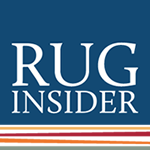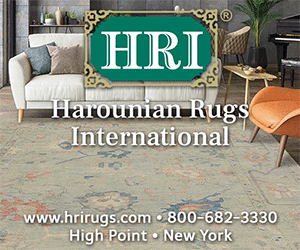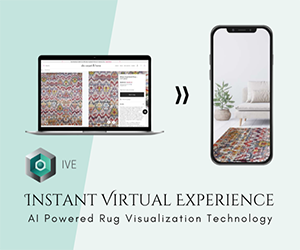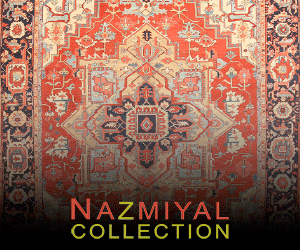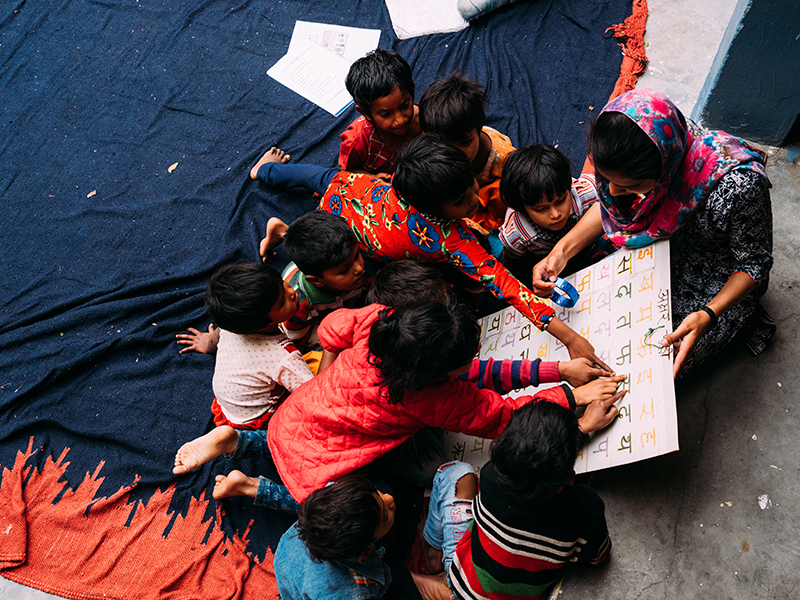“We believe labor is an important part of the supply chain, and our workers must be treated with the dignity and respect they deserve,” declares Patrick McDarrah, President of Emma Gardner Design, in New York City.
Erika Kurtz, Chief Operating Officer of New Moon Rugs based in Wilmington DE, shares his commitment. However, she acknowledges, a concerned American company can’t see the situations their workers face thousands of miles away.
“When you’re working from afar—as well-intentioned as you might be—it’s impossible to know what may or may not be happening at your mill when you’re not there. Facilities change, people come and go. There are so many moving parts.”
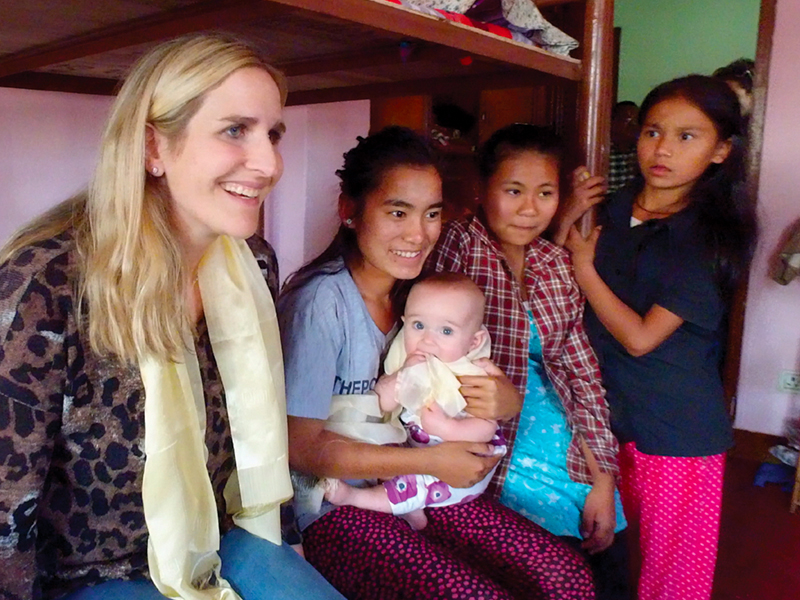
Erika Kurtz with her daughter and three children currently at Hamro Ghar. © New Moon Rugs
“It brings peace of mind to have GoodWeave providing drop-in inspection and supervision so that things aren’t happening that I don’t know about.“ ERIKA KURTZ, NEW MOON RUGS
Both McDarrah and Kurtz selected the same source of protection for their workers in Nepal: GoodWeave International. This non-profit organization, founded in 1994 by Nobel laureate Kailash Satyarthi, is the leading global institution working to stop child and forced labor in supply chains. They have already restored freedom to 10,876 children and provided educational opportunities to 102,856. In 2004, over 125,000 workers were protected under the GoodWeave Standard. Their global impact goes beyond numbers, as GoodWeave promotes ethical labor practices and safeguards the rights of children and workers.
Partnering with GoodWeave, “was a necessary step for us, because of the tension between Western standards, ideals, customs and history, and those in less developed communities,” explains McDarrah. “The idea of a family working together may be accepted in less [modernized] countries, so it can seem natural to have children at work near their parents, like at a family farm in the US. In either case, local monitoring is the only way to overcome those traditions.”
For Kurtz, “It brings peace of mind to have GoodWeave providing drop-in inspection and supervision so that things aren’t happening that I don’t know about. If New Moon can’t provide logistical support, it’s important to have an impartial third party there for us. To me, that support on the ground is invaluable.”
PROTECTING CHILDREN
Since 2016, Lucy Tupu, Creative Director of Lucy Tupu Design Studio, in New York and New Zealand, has partnered with GoodWeave “to insure there’s no child labor. I think that’s an important part of the process. I want to be sure that my workers are taken care of,” affirms Tupu. “They do beautiful, amazing work—part of [this] is honoring them, and what they do, and the way that they do it.”
Tupu appreciates GoodWeave’s regular visits to each factory, to support “education for the kids and better working conditions,” as well as other valuable benefits. Frequent updates report “the impact they have on a community, including how many children have been affected. It’s almost like a newsletter, telling us about current risks to vulnerable [areas]. We learn who’s in leadership roles, and what’s happening in education, working conditions and children’s rights in that specific location. It’s important to me that the money we pay as fees goes to the community, to make certain that we’re giving back that way,” she adds.
Lucy Tupu Design Studio’s rugs are made at a family-run business in Katmandu. “I’m always talking to the founder/owner, making sure that he and his family and the people who work for them are okay,” says Tupu.
Kurtz has visited Nepal once or twice a year, since the early 1990s. When her father, company founder John Kurtz, first started production there, “the humanitarian aspects were important to him,” she recounts. He was working with USAID to help teach people about rug production and their rights. New Moon soon aligned with GoodWeave, when it began, as a “third party that would make sure there was oversight.
Kurtz calls GoodWeave’s Hamro Ghar facility, “near and dear to my heart. What do you do if you find something wrong in a workplace?” she asks. ”Hamro Ghar is a program that offers the ability to move forward. It’s a boarding school for when they’ve rescued a child from a factory, and couldn’t find the parents. It allows a child to get an education in a structured social setting. There is so much more than can be done to improve the system well beyond the inspection process. I find this program so meaningful, I’ve been taking my daughter on my visits there since she was a baby. We bring school supplies, see what they’re doing, and let the children know that we care about helping them.”
“In less developed countries, young people may often need to work, due to poverty, migration, or family separation,” admits McDarrah. To monitor this delicate situation, “GoodWeave is for real. They’re professional and thorough, with a local infrastructure of people who speak the language and can talk to the worker who’s trying to support their family. Local staff does the work. Unless you’ve got these teams, it can’t be done.”
EXPANDING THE OPPORTUNITIES
GoodWeave is headquartered in Washington DC, with locally-led affiliates in South Asia and Europe. “We don’t just identify child labor in supply chains—we offer holistic solutions,” explains Navneet Singh, Deputy Director, GoodWeave. “Our work extends into remediation, education, health, and sustained community engagement. This integrative approach restores dignity and opportunity to [those who are] most vulnerable.”
In India, the legal minimum age for employment is 14 years. Adolescents between 14 and 18 years are allowed to work only in non-hazardous occupations. Specific regulations concern their working hours and mandatory rest periods. In Nepal, children between 14 and 17 are not permitted to work in any industry considered hazardous, which includes the carpet industry.
Convinced that sustainable change begins at the community level, GoodWeave runs the Child Friendly Community Program (CFC), in collaboration with MSEMVS, another not-for-profit organization striving to eliminate child labor. The CFC tests learning levels for at-risk children, focusing on their proficiency in math, reading, writing, Hindi and English. Those scoring below grade level are sent to Motivational Learning Centers, where formal education helps them catch up.
CFC’s academic approaches can bring impressive results. Struggling students sometimes progress so much they qualify for government scholarship exams! “This opens a pathway to. continuing education,” says Singh. For adolescent girls, they provide valuable Life Skills Education. “Sessions on decision-making, puberty, career [possibilities] and personal hygiene improve their confidence and empower them to dream bigger, to make informed choices about their future,” says Singh. In a program explaining their rights, girls might learn they do not have to marry at 14. Women of any age are encouraged to complete a high school education, even within a culture stressing the importance of husband and child.
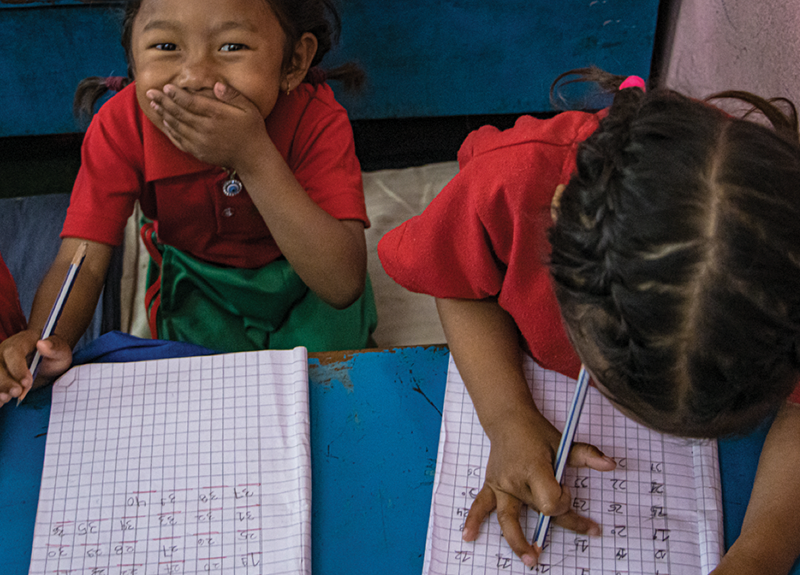
Children participate in a classroom lesson at a daycare center in Nepal. © Nikki Thapa / GoodWeave International
In 2021, GoodWeave began a CFC program in a small village in Uttar Pradesh, where 147 school-age children live. “School attendance was alarmingly low—just 30%. But through consistent community engagement, awareness campaigns, and child-focused interventions, attendance steadily improved. After three years, the attendance rate has passed 90%,” Singh reports proudly. When the school received an award for the 2022-23 school year, the principal credited GoodWeave’s team for their vital role in this transformation. “This achievement reflects the power of collaboration in creating child-friendly, education-focused communities.”
In India, local residents sometimes choose to run a particular CFC as a type of day care center. That allows parents to drop off their children there, on the way to work.
GoodWeave’s Child Protection Committees help villagers become active advocates of education and protectors of children’s rights. “This fosters a powerful cultural shift,” says Singh. “Communities understand the value of education, and their responsibility to ensure that no child in their village is subjected to labor.”
Partners especially appreciate GoodWeave’s broader programs, like those addressing the health and well-being of weavers and artisans. For example, when free eye check-ups and “health camps” reach the communities where the rugs are produced, they’re significantly supporting the extended families of workers.
“We see GoodWeave as a critical partner in our business, and cherish what they do … They’re necessary in our supply chain!“ PATRICK McDARRAH, EMMA GARDNER DESIGN
INDUSTRY INVOLVEMENT
“Many of our licensed partners tell us that their association with GoodWeave makes them both proud and confident—that their supply chains are being monitored with integrity, and their products are produced without child labor, forced or bonded labor,” reflects Singh. “What partners value most is that we don’t just point out problems—we make them part of the solution.”
Originally focused on the rug industry, GoodWeave has expanded its successful model into home textiles, brick kilns, and apparel and fashion accessories. Now a leading influence in the global effort to end child labor, the organization understands that laws alone aren’t enough. Real change occurs with due diligence, remediation, preventions and their holistic approach to end child, forced and bonded labor. When GoodWeave discovers child labor, it works to understand the underlying reasons why this child is working, and intervenes to address the root causes.
Often, licensed partners are unaware of major noncompliance in their supply chain until GoodWeave alerts them. Then, GoodWeave collaborates with suppliers to address noncompliance—requiring them to implement all recommended corrective actions, to meet the organization’s standard.
GoodWeave’s business model is built on trusted partnerships. It includes retail and brand importers in over 20 countries, as well as producers in India and Nepal. In both producer countries, local teams include business development, inspection, and monitoring staff. The teams are vital for maintaining oversight and providing support where needed.
To be licensed by GoodWeave, companies must commit to meet rigorous certification standards that prohibit child, forced, and bonded labor. They are requested to ensure safe and decent working conditions throughout their supply chains. Once it gains full visibility of a partner’s supply chain, GoodWeave conducts annual announced audits. These are followed by random and unannounced inspections at both primary and subcontracted locations, including home-based sites. Local auditors who are fluent in regional languages assess each site thoroughly, to verify compliance with the GoodWeave standard.
Any child under 14 found working is immediately withdrawn and referred to a local social worker. Remediation begins with family and community engagement. “Families are asked to cooperate so the child can return to school,” says Singh. “If income is lost, GoodWeave [offers] the option of a stipend, contingent on school enrollment and attendance, and follows up with the family regularly.”
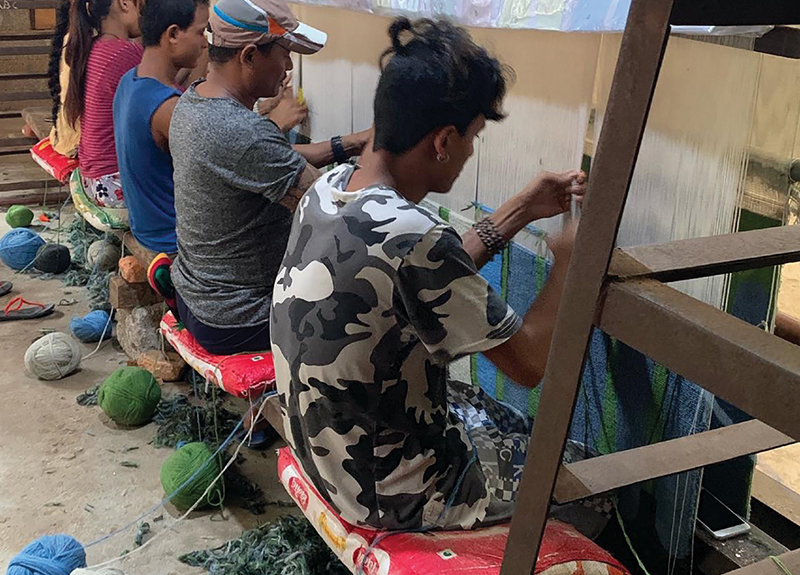
Weavers at the Kathmandu Nepal-based production facility where all of Emma Gardner’s rugs are made. © Emma Gardner Design
Once a supplier becomes licensed by GoodWeave, their nominated importer can request GoodWeave labels for their products. Licensees receive training, so that their sales and marketing teams can clearly communicate the label’s significance.
“Many people want to know that their beautiful, hand-knotted piece didn’t come at the cost of someone else’s well-being—especially a child’s,” Singh observes. “Increasingly, younger consumers want to know the story. It resonates deeply when that story includes sustainable positive community and impact. When brands highlight that their rugs are GoodWeave certified and that they’re supporting education and improved working conditions in weaving communities, it builds trust and adds meaningful value to the product.”
“We see GoodWeave as a critical partner in our business, and cherish what they do,” affirms McDarrah. “We believe that we must include them—they’re necessary in our supply chain! They are part of us.”
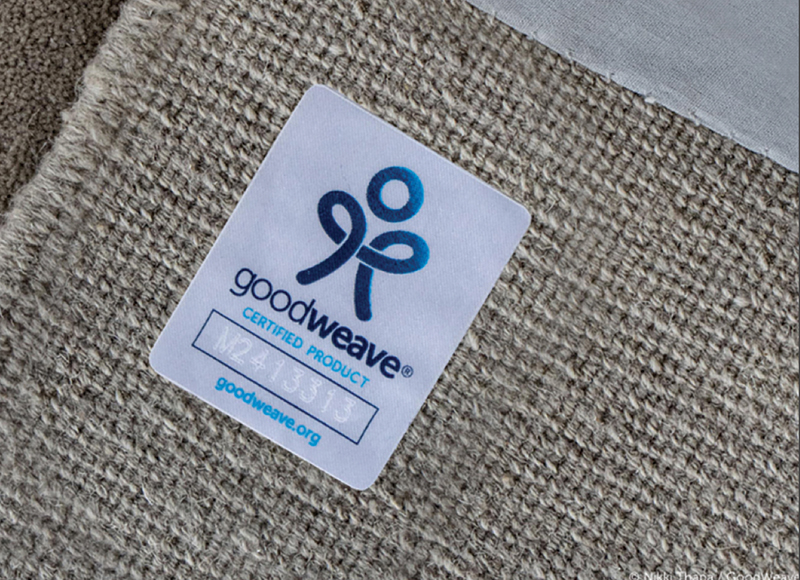
A certified rug featuring the GoodWeave label—the best assurance it was made free of child and forced labor. ©Nikki Thapa/GoodWeave International

